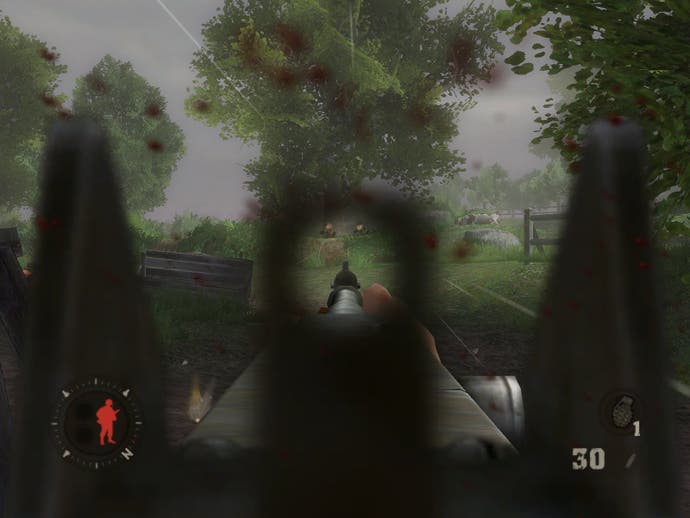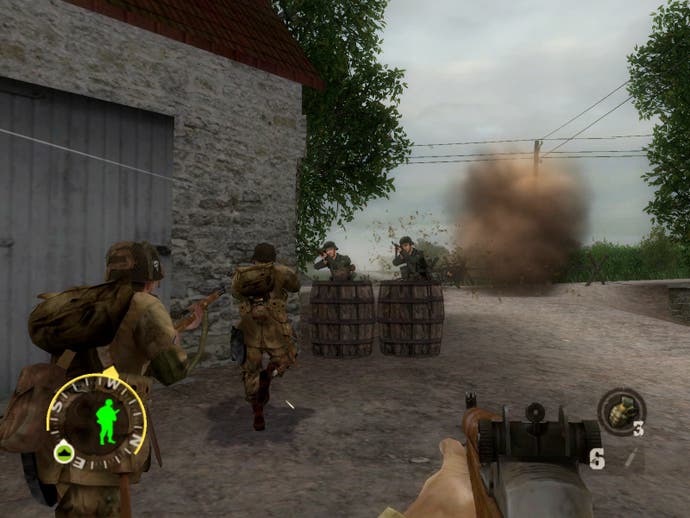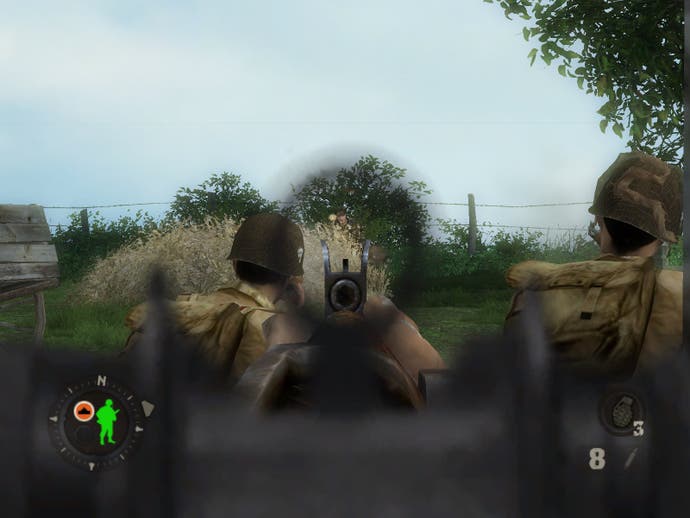Brothers In Arms: Road To Hill 30
We always knew Mark Knopfler had it in him.
Regular visitors to these hallowed pages will know by now that we've got very mixed feelings about the ongoing videogaming obsession with World War II. In short, it's gone beyond merely lacking the imagination to come up with something vaguely new, and descended into the realms of exasperating self parody where game publishers are only too happy to sign developers connected with Call Of Valor: Medal Of Duty. The thing is, however much we mock, the public just lap it up. It's a veritable money-printing machine.
This feeding frenzy on famous conflicts know no bounds, so it hardly came as a surprise when a well-known game developer asked us recently for our thoughts on whether they should do a World War II game. It was a dicey moment where those jovial 'mixed' feelings could have so easily spilled over into an explosion of Hulkian rage. It's all right for them. They don't have to review 48 of the buggers every single year. There are only so many wars the average game reviewer can fight before the ugly symptoms of post-traumatic stress disorder begin to peep above the parapet.
Oh what a lovely war

And so onto part 123 of our love affair with everyone's favourite war. You'd probably imagine that we're battle-weary, cynical and closed-minded to the idea of another WWII-based title. You know, we ought to be by now. The difference is the difference. Brothers In Arms is unlike any other WW2 game we've ever played, feeling more like a logical progression from Full Spectrum Warrior than another tired, linear, corridor-based run and gun.
As the title illustrates rather neatly, the focus in Brothers In Arms is around the events of the eight days leading up to the climactic battle of Hill 30 on June 13th 1944. Kicking off briefly in the midst of an intense struggle on that very day, the game quickly flashes back to the start of this epic campaign on D-Day; June 6th. With obvious narrative influence from the excellent Band Of Brothers TV show each mission kicks off with white text on a black screen, with the sombre delivery of Sgt Matt Baker regaling his inner hopes and fears of how he never asked to be squad leader, that 13 men and 13 families were relying on him, and the acknowledgement that 13 was definitely not a lucky number to be associated with.
Although there is a tutorial should you require one, Brothers In Arms neatly sidesteps such a contrived approach by gradually filling you in on all you need to know as and when you require. The first and most important element that distances BIA from the herd is your ability to tactically direct squad mates quickly and efficiently. Rather like FSW, you have the facility to move your men between cover points and attack targets with precision and ease. The difference is that this time you're also fully in control of a soldier in the true FPS sense as well, which makes the whole experience much more involving, more personal, opens up far more ways to tackle each mission and is therefore less of a contrived puzzle game where you never get to pull the trigger.
Let's see the whites of your eyes

As much as we loved Pandemic's gem for what it was, there was always the sense that you wanted to see the whites of the enemy's eyes and not merely bark instructions from the sidelines. Likewise, BIA scores extra points for being one of the few war games where your squad mates aren't just pointless cinematic cannon fodder like all the rest. If you try to play BIA like a traditional 'lone wolf' one-man-against-the-world FPS you'll almost certainly die within seconds. At its best, BIA is enthralling, tactical, strategic, logical, and very satisfying.
Should you require it, BIA even offers up a Situational Awareness mode that allows you to pause the game in an instant and effectively peruse your surroundings from a scalable, rotatable isometric view. Any enemies you've already spotted will appear behind their cover points, and it effectively gives you an extra chance to plot your strategy ahead of time. To be honest, although it seemed initially like a good idea, we found it a bit clunky to navigate around and gave up using it pretty quickly. Still: credit to Gearbox for trying.
One of the key gameplay components crucial to how BIA works is the use of a Suppression Indicator that looks a bit like a pie chart above the heads of the enemy. As soon as you see an enemy soldier the icon appears right above them to show you how likely they are to fire at you, and - ultimately - how accurate they will be. Initially the indicator will be red to indicate that the enemy is at his most dangerous, but commanding your men to rain suppressive fire at them reduces the threat of the enemy in terms of their ability to fire back and their accuracy. Doing so gradually turns the icon grey, and with the enemy pinned down behind cover you'll be able to take advantage of their weakness and outflank them. The flexibility of the game means you can either do the flanking yourself and be the daring hero or direct your squaddies to go and take them out while you bask in the safer role of suppresser behind cover. Later on you might even have the added benefit of a tank or second Assault Team squad to add to your suppression-specialist Fire Team to aid you with your dirty flanking work, but it certainly feels more fun being able to creep up on unsuspecting enemies and cap them while they're busy spouting Deutsch at us. We'll never tire of that.
Couldn't hit a barn door with a rocket launcher?

A slight dose of realism has also been added to the basic shooting mechanics as well, with the default first-person 'shoot from the hip' view giving you virtually no chance of getting a shot on target. Hitting the aim button lets you look down the sight of the gun, and is realistically the only way to guarantee you'll be able to shoot straight. Even so, the drift of the gun is so pronounced (compared to other similar, more forgiving games) that almost every time you pull the trigger you'll be wrestling the sight back towards your intended target once again.
As with real fire fights, going into a crouched position makes you even more accurate, but at the expense of speed - meaning your degree of cover is all important at virtually all times, and unlike every other FPS out there, there are no "magic" health packs to bring you back to life, or even a 100 unit health bar to monitor how close to death you are (instead the HUD displays health in colour-coded terms; with green meaning healthy through to red for danger). Gearbox clearly doesn't subscribe to the notion of playing it by the accepted FPS rules, and for the most part the game is all the better because of it.
But although all of this dogged adherence to supposed 'realism' might sound like a recipe for a nightmare of a game where you're always struggling to make progress, Gearbox has been mindful to keep the frustration factor to a relative minimum. For a start there are four difficulty levels, with Normal perfectly pitched between offering a decent challenge and trying to sustain the player's motivation. For example, although you can't manually save your progress, the game keeps the tension high by checkpointing sensibly, and supplements this system by offering the player the opportunity to heal once you've failed a particular section three times in a row. Not only that, but any incapacitated squad mates will reappear, making the task ahead that much easier. To paraphrase the game itself, War isn't fair, but this is after all a videogame - games are supposed to be fun, and BIA makes sure you're not going to give up that easily on the 12 hour, 17 level quest. And for good measure there are plenty of unlockables to enjoy if you can be bothered to go back and tackle the game on higher difficulty settings, such as documentaries and aerial photographs to illustrate just how closely the game matches its real life setting.
Twisting by the pool of blood

Possibly the only things that lets down an otherwise top class package is some occasionally brainless suicidal AI ("please shoot me, oh go on. Coo-ie! Nazi over here!"), a few, mercifully rare path-finding hitches that send squad mates scurrying off to their doom when a safer route seemed more obvious, and visuals which stray sometimes into the realm of 'last gen' when held up next to some of the more recent games doing the rounds in the FPS genre. Unfair comparison, maybe, and it's obvious the game's console focus is to blame here, but nevertheless it's a moot point that PC owners have to accept as one of the realities of modern, multiformat game development. Even so, the game has a few tricks up its sleeve - notably the way bullets kick up dust and debris, and the excellent visual effects used to convey being shot and injured, with the screen briefly being sprayed with blood or some other vision-obscuring filter. The way you get knocked for six when a grenade goes off nearby is similarly outstanding.
Overall there's a general pleasant misty-eyed appeal about the whole thing, with Gearbox clearly guilty of a fondness for bright shades of green against a backdrop of shattered villages and rural desolation. It's easily up there with Call Of Duty, with well animated characters that take sensible cover and always react to danger and respond in kind. BIA always delivers a sound, convincing attention to detail, but doesn't get near, say, Pacific Assault in most respects. Not that it matters, as it's better than all of its rivals for atmosphere, playability and the sheer suspension of disbelief that none of these formulaic pretenders can pull off. Sometimes you have to defend a game's weaknesses for all the other strengths it possesses, and BIA seems to excel in most of the areas that really count.
For once, even the audio deserves praise, with a deliberate lack of pointless sweeping strings in-game making it much more about the endlessly varied squad chatter and the deafening roar of the guns than about the movie-esque score. Gearbox left that for the menus, thank goodness. Yes, maybe the voice acting is a little earnest and serious, but you have to agree the schmaltz is a mere fraction of its rivals. If we weren't so jaded by this endlessly repeated approach we'd probably be moved to observe that it's pretty good. We're still bothered about the obsession with the US' role in the war, though. Anyone would think they won it single-handedly if you learned your history through playing videogames.
Walk of Life

Ahem. Once you're done with the single-player fun, it's our happy duty to report that there's a grand multiplayer experience awaiting that is far more than some of the usual tacked-on efforts that we generally find ourselves reporting on. If anything it's an almost unique multiplayer FPS challenge for managing to retain the squad control aspects of the single-player game. Sporting 10 maps, games can be set up for up to four players with the general objective being to demolish a key target over the other side of the map. Every player gets to take charge of one or two squads, with the added bonus of being able to take charge of another squad member should you cop it in the battle - unlike the single-player version which only lets you control Sgt Baker. Also, should your entire team get wiped out you start over at the original spawn position.
Much like the single-player element, the beauty of it is the ability to play it however you want, either going for all out rushes or a more strategic squad-based approach. We reckon the real winners will be the ones who master their strategy though, as BIA is far from simply a game where the sharpest shooters win out. Being handy with a gun will help, obviously, but it's not the be all and end all, and as such gets our vote for doing something refreshingly different with the genre.
And on that note, we have our faith in World War II games utterly, comprehensively restored. It seems incredible that such a saturated genre can still produce something fresh, but Gearbox deserves big manly bear hugs and ferocious slaps on the back for delivering on its promises. Its current chart success is well deserved, and for those of you bored of Medal Of Honor and jaded about Call Of Duty's me-too approach and stubbornly unconvinced that Brothers In Arms really doesn't offer anything new, we suggest you try it. You might just love it.


